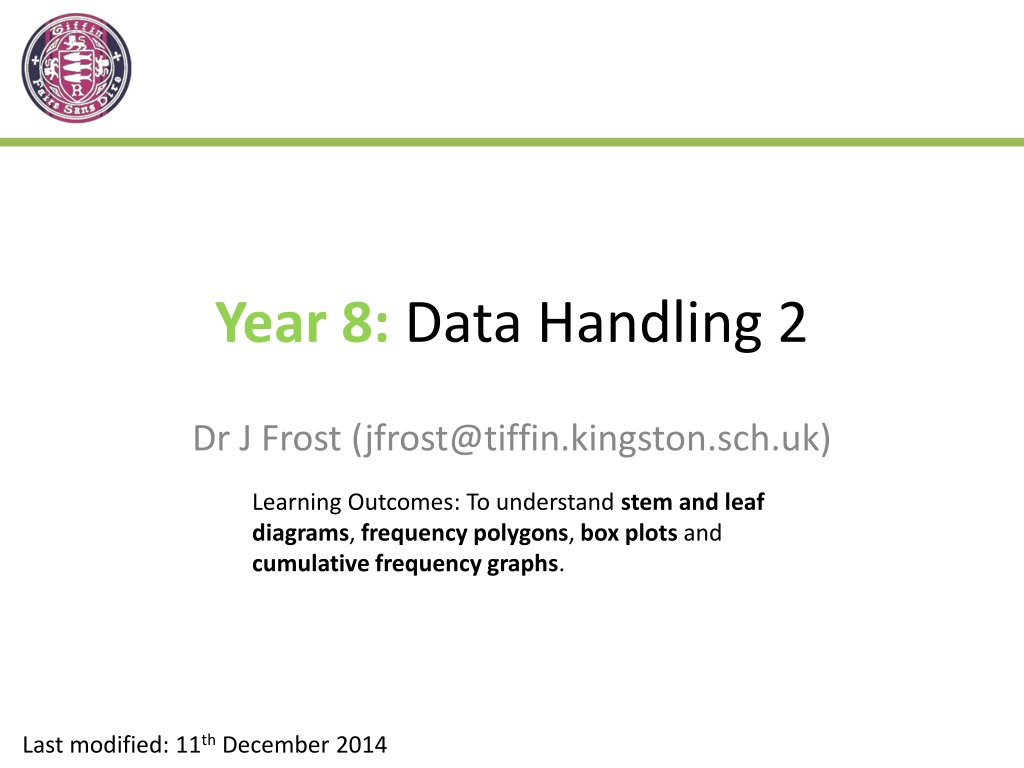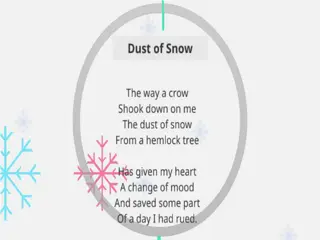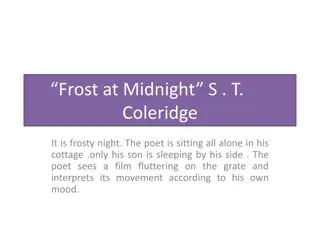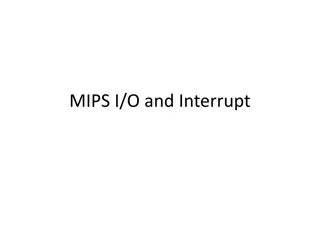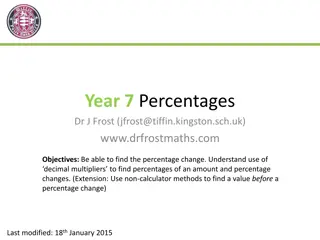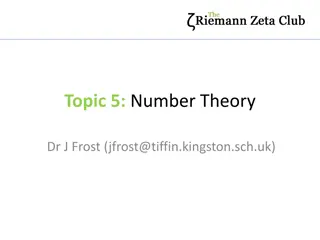Exploring Data Handling Techniques with Dr. J. Frost
Dive into the world of data handling with Dr. J. Frost as you learn about stem-and-leaf diagrams, frequency polygons, box plots, and cumulative frequency graphs. Understand how to represent data effectively and analyze patterns using these visualization methods.
Download Presentation

Please find below an Image/Link to download the presentation.
The content on the website is provided AS IS for your information and personal use only. It may not be sold, licensed, or shared on other websites without obtaining consent from the author. Download presentation by click this link. If you encounter any issues during the download, it is possible that the publisher has removed the file from their server.
E N D
Presentation Transcript
Year 8: Data Handling 2 Dr J Frost (jfrost@tiffin.kingston.sch.uk) Learning Outcomes: To understand stem and leaf diagrams, frequency polygons, box plots and cumulative frequency graphs. Last modified: 11th December 2014
Stem and Leaf Diagram - What is it? Suppose this stem and leaf diagram represents the lengths of beetles. The key tells us how two digits combine. 1 2 3 4 5 4 1 2 4 5 2 5 6 6 6 7 7 8 8 0 1 2 2 4 5 6 7 7 7 7 8 0 1 1 2 Key: 2 | 1 means 2.1cm The numbers must be in order. Value represented = 4.5cm ? These numbers represent the first digit of the number. These numbers represent the second.
Example Here are the weights of a group of cats. Draw a stem-and-leaf diagram to represent this data. 36kg 15kg 35kg 50kg 11kg 36kg 38kg 47kg 12kg 30kg 18kg 57kg ? 1 1 2 5 8 Key: 3 | 8 means 38kg ? 2 ? ? 3 ? 0 5 6 6 8 What do you think are the advantages of displaying data in a stem-and-leaf diagram? 4 7 ? ? 5 0 7 Shows how the data is spread out. Identifies gaps in the values. All the original data is preserved (i.e. we don t summarise in any way). ?
Your turn Here is the brain diameter of a number of members of 8IW. Draw a stem and leaf diagram representing this data. 1.3cm 2.1cm 5.3cm 2.0cm 1.7cm 4.2cm 3.3cm 3.2cm 1.3cm 4.6cm 1.9cm ? 1 3 3 7 9 Key: 3 | 8 means 3.8cm ? 2 0 1 ? ? 3 ? 2 3 4 2 6 ? ? 5 3 ? Median width = 2.1cm ? ? Lower Quartile = 1.7cm Upper Quartile = 4.2cm
Exercises Q1 on your provided worksheet. (Ref: Yr8-DataHandlingWorksheet.doc)
Frequency Diagram Suppose we wanted to plot the following data, where each value has a frequency. A suitable representation of this data would be a bar chart. ? Shoe Size Frequency 8 26 100 9 42 80 Frequency 10 103 11 34 60 12 5 40 20 When bar charts have frequency on the y-axis, they re known as frequency diagrams. 8 9 10 11 12 Shoe size
Frequency Polygons But suppose that we had data grouped into ranges. What would be a sensible value to represent each range? IQ (x) Frequency 90 x < 100 2 16 100 x < 110 15 Join the points up with straight lines. 14 110 x < 120 8 12 120 x < 130 0 130 x < 140 4 10 8 Modal class interval: 100 x < 110 ? 6 4 This is known as a frequency polygon. 2 90 100 110 120 130 140
Frequency Polygons Exercises on sheet Q1 Q2 ? ? ? ? b) 30 < x 40 c) 16% ? ? b) 20 < x 30 c) 16%
The Whole Picture Frequency Polygon Histogram Grouped Frequency Table Cumulative Frequency Table Widths (cm): 4, 4, 7, 9, 11, 12, 14, 15, 15, 18, 28, 42 Width (cm) Frequency Width (cm) Cum Freq 0 < w < 10 4 0 < w < 10 4 10 < w < 25 6 0 < w < 25 10 25 < w < 60 2 0 < w < 60 12 Determine Median/LQ/UQ Median/LQ/UQ class interval Cumulative Frequency Graph Estimate of Median/LQ/UQ/num values in range Box Plots
Recap: Lower and Upper Quartile Suppose that we line up everyone in the school according to height. 50% The height of the person 25% along the line is known as the: lower quartile ? We already know that the median would be the middle person s height. The upper quartile is the height of the person 75% along the data. 50% of the people in the school would have a height less than them.
Check your understanding ? 50% of the data has a value more than the median. ? 75% of the data has a value less than the upper quartile. ? 25% of the data has a value more than the upper quartile. ? 75% of the data has a value more than the lower quartile. 0% 25% 50% 75% 100% LQ Median UQ
Median/Quartile Revision Here are the ages of 10 people at Pablo s party. Choose the correct value. 12, 13, 14, 14, 15, 16, 16, 17, 19, 24 (Click to vote) 15.5 15 16 Median: 14 13 13.5 Lower: 17 18 19 UQ: Interquartile Range: 3 12 ? ? Range:
Quickfire Quartiles LQ Median UQ 1, 2, 3 1 ? 2 ? 3 ? 1.5 ? 2.5 ? 3.5 ? 1, 2, 3, 4 1, 2, 3, 4, 5 1.5 ? 2 ? 4.5 ? 2 ? 3.5 ? 5 ? 1, 2, 3, 4, 5, 6 Rule for lower quartile: Even num of items: find median of bottom half. Odd num of items: throw away middle item, find medium of remaining half.
What if theres lots of items? There are 31 items, in order of value. What items should we use for the median and lower/upper quartiles? 0 1 1 2 4 5 5 6 7 8 10 10 14 14 14 14 15 16 17 29 31 31 37 37 38 39 40 40 41 43 44 Use 1 Use the 8 th item 4? + 1? item LQ ? Use 1 2? + 1? item Median ? Use the 16th item Use 3 4? + 1? item Use the 24th item ? UQ
What if theres lots of items? Num items LQ Median UQ 4th ? 8th ? 12th ? 15 6th 12th ? 18th ? 23 ? 10th 20th ? 30th ? 39 ? ? ? ? 12th 24th 36th 47
Box Plots Box Plots allow us to visually represent the distribution of the data. Minimum Maximum Median Lower Quartile Upper Quartile 3 27 17 15 22 Sketch Sketch Sketch Sketch Sketch range IQR 0 5 10 15 20 25 30 How is the IQR represented in this diagram? How is the range represented in this diagram? Sketch Sketch
Box Plots Sketch a box plot to represent the given weights of cats: 5lb, 6lb, 7.5lb, 8lb, 8lb, 9lb, 12lb, 14lb, 20lb Minimum Maximum Median Lower Quartile Upper Quartile ? ? ? ? ? 5 20 8 6.75 13 0 4 8 12 16 20 24 Sketch
Box Plots Sketch a box plot to represent the given ages of people at Dhruv s party: 5, 12, 13, 13, 14, 16, 22 Minimum Maximum Median Lower Quartile Upper Quartile ? ? ? ? ? 5 22 13 12 16 0 4 8 12 16 20 24 Sketch
Comparing Box Plots Box Plot comparing house prices of Croydon and Kingston-upon-Thames. Croydon Kingston 100k 150k 200k 250k 300k 350k 400k 450k Compare the prices of houses in Croydon with those in Kingston . (2 marks) For 1 mark, one of: In interquartile range of house prices in Kingston is greater than Croydon. The range of house prices in Kingston is greater than Croydon. ? For 1 mark: The median house price in Kingston was greater than that in Croydon. (Note that in old mark schemes, comparing the minimum/maximum/quartiles would have been acceptable, but currently, you MUST compare the median) ?
100m times at the 2012 London Olympics Modal class interval ? 10.05 < t 10.2 Median class interval ? 10.05 < t 10.2 Estimate of mean ? 10.02 Time (s) Frequency Cum Freq ? ? ? ? 9.6 < t 9.7 1 1 9.7 < t 9.9 4 5 9.9 < t 10.05 10 15 10.05 < t 10.2 17 32 TOTAL
Cumulative Frequency Graphs Time (s) Frequency Cum Freq 9.6 < t 9.7 1 1 Plot This graph tells us how many people had this value or less . 9.7 < t 9.9 4 5 Plot 9.9 < t 10.05 10 15 Plot 32 Plot 10.05 < t 10.2 17 32 ? 28 Median = 10.07s Cumulative Frequency 24 Lower Quartile = 9.95s ? 20 16 Upper Quartile = 10.13s ? 12 8 Interquartile Range = 0.18s ? 4 0 9.5 9.6 9.7 9.8 9.9 10.0 10.1 10.2 10.3 Time (s)
A Cumulative Frequency Graph is very useful for finding the number of values greater/smaller than some value, or within a range. Cumulative Frequency Graphs Estimate how many runners had a time less than 10.15s. 32 28 26 runners ? Cumulative Frequency 24 Estimate how many runners had a time more than 9.95 20 16 32 8 = 24 runners ? 12 Estimate how many runners had a time between 9.8s and 10s 8 4 11 3 = 8 runners ? 0 9.5 9.6 9.7 9.8 9.9 10.0 10.1 10.2 10.3 Time (s)
Time (s) Frequency Cum Freq 9.6 < t 9.7 1 1 Plot 9.7 < t 9.9 4 5 Plot Sketch Line 9.9 < t 10.05 17 22 Plot Plot 10.05 < t 10.2 10 32 Cumulative Frequency Graph Frequency Polygon Cumulative Frequency 32 18 28 16 Frequency 24 14 20 12 16 10 12 8 8 4 4 2 0 0 9.5 9.6 9.7 9.8 9.9 10.0 10.1 10.2 Time (s) 9.5 9.6 9.7 9.8 9.9 10.0 10.1 10.2 10.3 Time (s)
Worksheet Cumulative Frequency Graphs Printed handout. Q5, 6, 7, 8, 9, 10 Reference: GCSE-GroupedDataCumFreq
? ??? 5 23 35 39 40 ? ? 179 ?
34 ? ? ? Lower Quartile = 16 Upper Quartile = 44.5
We previously found: Minimum = 9, Maximum = 57, LQ = 16, Median = 34, UQ = 44.5 ? 1 mark: Range/interquartile range of boys times is greater. 1 mark: Median of boys times is greater. ?
44 100 134 153 160 ? ? 25 < ? 35 30 ? ? 40.9 24.1 = 16.8 ?
? ? ? ? C D B A
